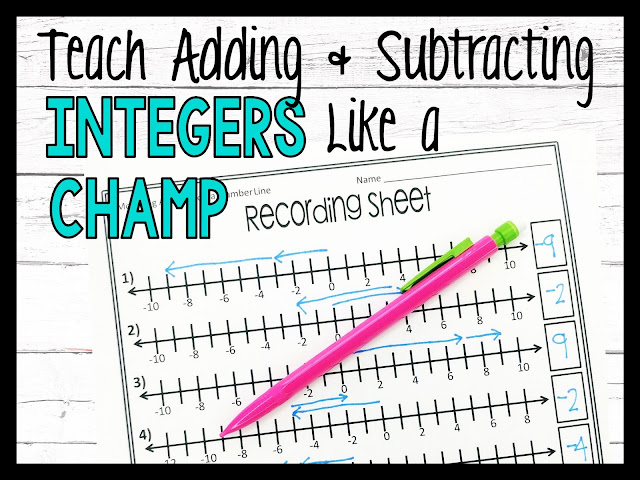How to Teach Adding and Subtracting Integers
Adding and subtracting integers can be a tough concept for middle school math students to comprehend. Especially if students have been taught that subtract always means to get smaller.
I want to share some tried and true successful ways to teach students how to successfully add and subtract integers.
I have found these strategies more successful than teaching only the integer "rules" which students have a hard time comprehending.
1) Use Number Lines
Number lines are essential when introducing adding and subtracting with integers.
I always found it easier to give students a paper with a bunch of number lines on them to speed up the process of teaching. Having students draw number lines for each problem can take a lot of time.
Another strategy I have done was to give students one number line in a protective sheet. Then they use a dry erase marker to draw on the number line for each problem. They can just erase the arrows after each problem. Also, students love dry erase markers...so that always creates extra engagement.
2) First is Addition
Start off by tackling addition of integers.
Pull out those number lines and model, model, model integer addition on number lines.
Another strategy beside number lines is using zero pairs. If you don't have manipulatives such as chips to model positives and negatives have students write the number of positives or negatives on their paper and cancel out zero pairs if needed, and voila, there is your answer.
3) Teach Subtracting as Adding the Opposite
Once students have tackled addition, then you can move to subtraction of integers.
The most successful teaching strategy I have found with subtraction is to have them change all subtraction problems into addition problems by adding the opposite. For example, 5 - (-3) changes to 5 + 3, because you add the opposite of the second number. Another example, -4 - 6 changes to -4 + (-6).
Having students circle the second number also helps those struggling with distinguishing between the subtraction sign and the negative sign.
You might need to remind students that when there is no written sign such as in -4 - 6, then 6 is positive, but then you will flip it to a negative.
4) Lots of Practice with Basic Numbers
Don't jump to adding and subtracting large value integers until they have a really good conceptual understanding. Do lots and lots of number lines and rewriting subtraction into addition.
I've got some adding and subtracting integers in my free resource library. They are great for students to make sense of adding and subtracting integers with a focus on number lines.
I've got some adding and subtracting integers in my free resource library. They are great for students to make sense of adding and subtracting integers with a focus on number lines.











